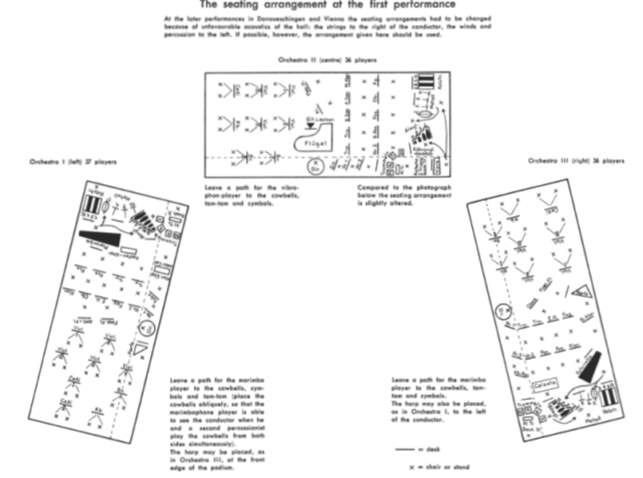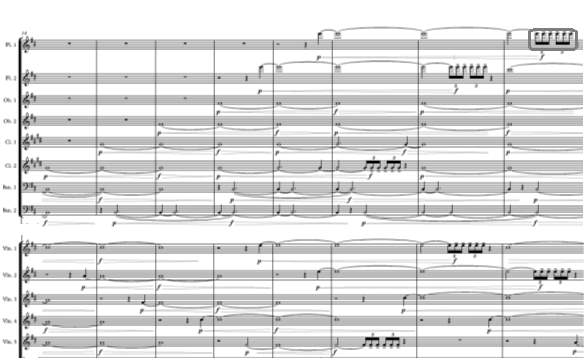Space and Place in Musical Compositions
Info: 16191 words (65 pages) Dissertation
Published: 10th Dec 2019
Tagged: Music
CONTENTS
PART I: COMMENTARY
Defining Works with a Relation to their Site
Use of Space in Music Throughout Time
CHAPTER III COMPOSITIONAL PROCESS
Audience-Performer Relationship and Considerations of Space
Choral Work: Missa Brevis Multas Partis
Considerations of Space and Sound
Audience-Performer Relationship
Orchestral Work: Understanding
Considerations of Space and Sound
Audience-Performer Relationship
Work for Two Pianos: Which Room?
Considerations of Space and Sound
Audience-Performer Relationship
Table 3: The Eight Categories of Performance (Schechner 2013: 31-34)
Paths of Sound Movement within each Orchestra Section in Understanding
PART II: SCORES
Soundscape: Fejn il-Baħar………………………………………..1
Choral: Missa Brevis Multas Partis…………………………………..4
Orchestral: Understanding……………………………………….27
Two Pianos: Which Room?……………………………………….47
PART III: ELECTRONIC MATERIAL
| Folder | File Name | Description |
|
Fejn il-Baħar Example 1 (Rough Sea).wav | Audio file combining Fejn il-Baħar.wav and an audio recording of rough sea, to demonstrate an example of appreciating the work in different sound scenarios. |
| Fejn il-Baħar Example 2 (Calm Sea).wav | Audio file combining Fejn il-Baħar.wav and an audio recording of calm sea, to demonstrate an example of appreciating the work in different sound scenarios. | |
| John Cage – Water Walk.mp4 | A copy of the video recording of John Cage live on air during a USA national television programme I’ve Got a Secret in 1960. Online Source: <http://exhibitions.nypl.org/johncage/node/28#fs> [accessed 18 January 2017] |
|
| Iannis Xenakis – Terretektorh für Orchester – Cresc. Biennale für Moderne Musik.mp4 | A copy of the video recording of a recent performance of Terretektorh, to demonstrate the idea of musicians scattered amongst an audience. Online Source: <https://www.youtube.com/watch?v=37ajOyhcl_c> [accessed 12 April 2017] | |
|
Fejn il-Baħar.wav | Audio file to be played using headphones by the sea. |
| Missa Brevis Multas Partis.wav | A digital rendition of the choral work. Note: This is not a perfect rendition of the work, as certain musical expressions are not perceived well.. | |
| Understanding.wav | A digital rendition of the orchestral work. Note: This is not a perfect rendition of the work, as certain sounds are not as perceived well in the recording. Sound movement is not present when using stereo speakers, hence the work should be heard live to understand its concept. | |
| Which Room.wav | A digital rendition of the work. Note: This is not a perfect rendition of the work, as certain musical expressions are not perceived well. |
TABLES
Table 1: Brant’s Views on Musical Spatiality (Harley 1997: 73-74)
Table 2: Features of a Soundscape, according to Schafer (1993: 9)
Table 3: The Eight Categories of Performance (Schechner 2013: 31-34)
FIGURES
Figure 3: Seating Arrangement for Gruppen (Stockhausen 1963: ii)
Figure 4: Seating Arrangement for Iannis Xenakis’ Terretektorh
Figure 5: Seating Arrangement for Iannis Xenakis’ Nomos Gamma
Figure 6: Seating Arrangement for Persephassa (Xenakis 1970: 40)
Figure 8: Fejn il-Baħar – Main Theme
Figure 9: Fejn il-Baħar – Introduction
Figure 10: Fejn il-Baħar – Introduction, Climax, and Recapitulation
Figure 11: Fejn il-Baħar – Climax Explosion, Air Hybrid 3, and 3-Band Reverb
Figure 12: Spatial Distribution Diagram for Understanding: Strings
Figure 13: Spatial Distribution Diagram for Understanding: Woodwinds
Figure 14: Spatial Distribution Diagram for Understanding: Brass
Figure 15: Spatial Distribution Diagram for Understanding: Percussion
EXAMPLES
Example 1: Excerpt from In Ecclesiis (Gabrieli 2012: 2)…………………….
Example 2: Excerpt from the Second Movement of Dies Irae¸ from Berlioz’s Grande Messe des Morts, Op. 5 (Berlioz 1902: 19)……
Example 3: Excerpt from Persephassa (Xenakis 1970: 16)…………………..
Example 4: Fig. 1 for Missa Brevis Multas Partis
Example 5: Excerpt from Kyrie (bars 1-5)……………………………….
Example 6: Excerpt from Sanctus (bars 1-6)……………………………..
Example 7: Excerpt from Agnus Dei (bars 1-7)…………………………..
Example 8: Main Melody from Agnus Dei (bars 1-7)……………………….
Example 9: Melody from Sanctus (bars 12-17)……………………………
Example 10: Excerpt from the score Understanding (bars 1-7), demonstrating the effect of a continuous moving sound on the Violins……
Example 11: Excerpt from the score Understanding (bars 14-21)………………
Example 12: Motive a (Understanding)………………………………..
Example 13: Motive a1 (Understanding)……………………………….
Example 14: Motive a2 (Understanding)
Example 15: Excerpt from Which Room? (bars1-4)………………………..
Example 16: Rhythm for Which Room?
ABSTRACT
Works of art which consist of a common factor between the work and their place has been explored by various methods and art forms throughout the years. In music, this has been researched significantly through spatial distribution of sound sources in dispersed areas of a space.
In this dissertation four music compositions are being presented, using space and place as a prominent composition tool. The purpose of this study is to explore this theme within the aesthetic nature of this type of work, while exploring ways of spatial distribution of sound sources. All of this will be concluded with an observation of the presumed relationship between performer and audience.
This dissertation is structured in two parts; Part One contains a Literature Review, followed by research on the Tools Used in the compositions, as well as the Compositional Processes of each work. These are followed by Conclusions, where an analysis will be carried out to study whether these works had reached their aim, which areas should be improved, and how could the idea be further developed.
Part Two contains the scores for all the works presented. A guideline of how these works should be performed will be presented for each piece. Part Three is Electronic Material compiled in a DVD divided into two folders: one containing audio-visual sources, and the other containing digital representations of the works.
| Keywords:
|
||
| MUSIC COMPOSITION | SPATIAL DISTRIBUTION | SPACE |
| PLACE | AESTHETICS | SOUND |
CHAPTER I
LITERATURE REVIEW
Overview
Composers throughout time, from the Venetian Polychoral Style to more recent contemporary composers, used the element of spatial placement as a compositional tool. The difference between space and place is that one is abstract, while the other is defined, as Tuan (1977) explains it.
It has been noted that certain works of art have a relationship with its place. Research by Wilkie (2002) and McAuley (2005) have discussed this in their papers, each proposing definitions with the different types of space-dependant performances. Both these researches were approached in a different manner. One should perceive this idea in notion of performance studies and performativity, something which music and performance researchers tend to have a varied understanding on (Madrid 2009).
Beranek & Mellow (2012) state that the shape of an enclosure affects the direction of reflection in which sound is produced. In order to achieve a desirable acoustical environment, there are several factors which one should keep in mind when designing a room, as Peters, Smith & Hollins suggest (2013). The case study presented for the work Out of Water reflects upon the levels of proximity between performer and audience, as well as the ‘extra live’ element of this work (Hill & Paris 2014).
The aesthetic element of music in space and place are found in various works and writings. These include composers and philosophers such as Iannis Xenakis, Karlheinz Stockhausen, Henry Brant, Charles Ives, and John Cage, giving their views on their perception on the topic.
Introduction
The placement of performers in space is a practice which was utilised throughout the years. Dating back to the Renaissance period, the development of the Venetian polychoral style using the two choir lofts at the Basilica of San Marco in Venice was one of the first uses of spatial distribution in music which is documented. In more contemporary times, composers such as Charles Ives, Henry Brant, Iannis Xenakis, Karlheinz Stockhausen, and John Cage have developed this idea in their works, implying new philosophical ideologies which give a different perspective of music in a physical or abstract space.
Tuan (1977: 3) distinguishes between the words space and place. Space is defined as something abstract, something which suggests freedom. While place is something more defined, something which instils security. Tuan further argues that the ideas of both words are required to define each other:
What begins as undifferentiated space becomes place as we get to know it better and endow it with value. Architects talk about the spatial qualities of place; they can equally well speak of the locational (place) qualities of space. (Tuan 1977: 6)
Defining Works with a Relation to their Site
Wilkie’s survey attempts to address the definition of site-specific performances. Her survey analyses who produces these performances in Britain, where do they ‘take place’, to what extent can one label a performance site-specific, and most importantly, ‘how is it variously defined’ (Wilkie 2002: 140). More specifically, the distinction between a site-specific performance or site-generic was challenged. Wilkie (2002: 149) proposes that this can be challenged in two ways. One is ‘to draw distinctions between levels of site-specificity’, mainly pointing out the difference to what a performance may be completely site-specific or not. The second way is to create new terminology which defines these differences. A possible continuum proposed by a performance collective called Wrights & Sites is used, where it locates ‘a variety of theatre practices in terms of their relationships to place’. Figure 1 illustrates these definitions.
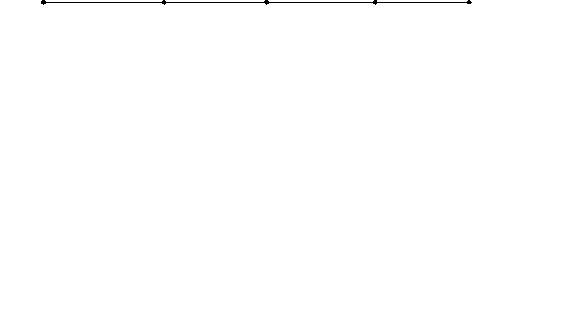
Figure 1: A Proposed Continuum defining the Different Types of Theatre Practices in relation to Place (Wilkie 2002: 150)
McAuley (2005: 30) has observed the concept of performers moving away from theatre buildings and perform in ‘found spaces in which new relations between performer and spectator can be explored, where the spectator gains a new kind of creative agency, and where the place itself acquires a voice’.
Classified in three categories, McAuley (2005: 31) had defined different situations in which this concept is applied to. The first category would be ‘work that seeks in a non-traditional site certain formal and aesthetic qualities that are needed for a particular production which might be under development well before the site is found’. It is work that has a ‘purely formal’ relationship between site and performance, even though ‘it is the work that determines the kind of site that is selected’. McAuley also notes that ‘it is evident that at its best there can be in this category of work a kind of symbiosis in the creative process whereby the site ends up marking and defining the work in complex ways’.
The second comprises of ‘work that emerges from an engagement with community, and hence from the place or places that are central to that community’. The artist and community are the main relationship, and the involvement with place emerges from those. However, it is a type of performance that ‘is not tied to a specific place and can successfully be taken to other places’ (McAuley 2005: 31).
The third is what McAuley (2005: 32) defines exclusively as site-specific, where ‘the work emerges from a particular place and engages with the history and politics of that place, and with the resonance of these in the present’. Therefore, it implies that ‘the work cannot travel’, it should stay at the site where it was produced.
According to Kaye, works of art related to their place and position imply a location. This therefore suggests that site-specific work is the specific relationship between a work of art and its location. This relationship also implies an ‘original and fixed position’ of what the work is (Kaye 2006: 1-2).
Richard Serra’s sculpture, Tilted Arc (1981), is an example of site-specific work, which was considered to be relocated to another location. Serra had then stated that moving the site-specific work to another place will destroy it (Senie 2002: 28-33). Kaye (2006: 2) furthers this statement: ‘To move the site-specific work is to re-place it, to make it something else.’
In conclusion to this argument, McAuley (2005: 32-33) uses Rachael Swain’s proposed term site-based rather than site-specific performance, a term she uses that reflects her own creative process.[1] This involves ‘developing the work in a highly specific place with a view to transporting it to different sites at a later stage’. This was adopted by McAuley in order ‘to indicate the broader range of pertinent relationships that can exist between place and performance’.
McAuley (2005: 33) refers to Wilkie’s proposed terms as approached ‘via the performance itself in its relation to its chosen site’, while McAuley’s categories of new found spaces are determined in relation ‘to the work process that produces the performance’.
Performance Studies and Music
The study of ‘practices, events, and behaviours’ dealt with interculturally is the main perspective of performance studies. Researchers in this field analyse the circumstances of a performance by its origin, its interaction with viewers, and its change over time (Schechner 2013: 2). Schechner (2013: 31-34) categorises performance in eight different activities, which may overlap with each other, as explained in Table 3 (Appendix A, pp 50-52).
It is noted by Augusto Boal in Schechner’s book (2013: vi) that every performance is unique, even if performed by the same performers. Schechner (2013: 30) further argues this by admitting that a performance is made from pieces of restored behaviour which is recombined in endless variations. This makes every performance unique, whether it is live, digitally produced, or even real life, according to its ‘specific occasion and context’. Moreover, this also includes the interactivity and reception of an audience.
Madrid (2009) notes that performance studies are based upon the concept of ‘performativity as a quality of discourse’. Music and performance researchers tend to have a varied understanding on the notion of performativity. A performance studies scholar would approach the study of music as what it ‘does or allows people to do’. With this approach, one may understand music ‘as processes within larger social and cultural practices’, while questioning the understanding of these processes.
Proxemics
Hall’s Proxemics is a study of the use of physical space in relation to the study of culture, defined as ‘the study of peoples’ use of their perceptual apparatus in different emotional states during different activities, in different relationships, settings, and context’ (Hall 1968: 95). With the aid of a chart, shown in Figure 2, Hall (1968: 92) has categorised the distances of these physical spaces as intimate, personal, social-consultive, and public.
One may misinterpret these encounters according to how a person may view it (Hall 1968: 95). Methods such as observation, experiment, and interviews (structured and unstructured) were used by Hall in his research (1968: 87-89), where he examines the perceptions of ‘the experience of (physical) space’ of people of different cultures, in relation to what is taken for granted by Americans. The results have shown how people of different cultures experience physical space in different ways, where it deemed to be offensive in some cases.
The study of proxemics has also been applied to technology.
Applying Hall’s concepts of proximity, McArthur’s work (2016: 3) ‘presupposes that digital technology could impact our movements in the physical world in dynamic ways’. Moreover, his work investigates the various ways of ‘how we move in spaces’ in relation to the ‘multiple roles of digital technologies in our use of space’, concluding that ‘Digital technology shapes the ways we move.’
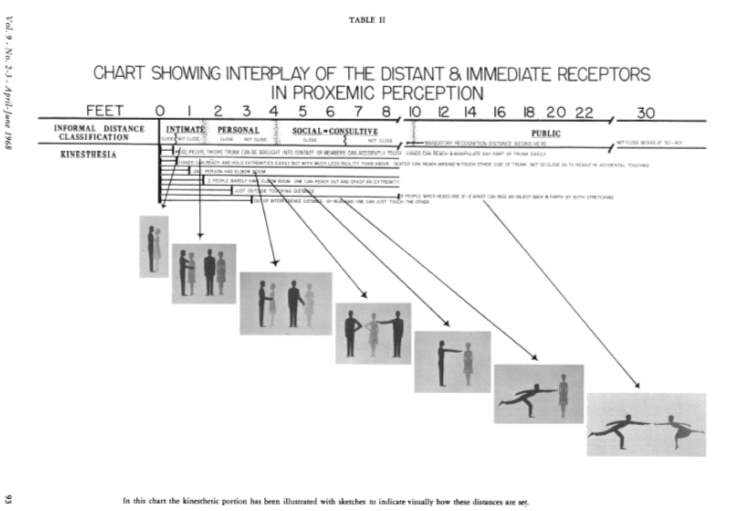
1
Figure 2: A chart taken from Hall’s Proxemics, explaining the Distances and Interplay of People (Hall 1968: 93)
Room Acoustics
Sound plain waves that travel in a small rectangular enclosure move in various directions, hitting all walls and corners. These reflect on themselves, forming stationary or standing waves, which are normal vibrations for the enclosure (Beranek & Mellow 2012: 450-51). In larger irregular enclosures, sound waves hit all the irregular walls and reflect ‘in all directions with equal probability’, defined as a diffuse sound field (ibid., 469).
To achieve a desired acoustical environment, a room needs to be designed with basic requirements in mind. Depending on the purpose of the space, an ‘optimum reverberation time’ is important (Peters, Smith & Hollins 2013: 120). Having too much will result in a diffused distribution of sound, whereas having too little, or near to zero, will result in no reflection of sound (ibid., 127).
The design of a room should also have an ‘optimum background noise level’, where it should not be too loud for it to interfere inside the designed room, while having it too low will result with ‘lack of acoustic privacy’. There should also be a satisfactory supply of sound to all parts of the room, distributed equally throughout the space (Peters, Smith & Hollins 2013: 127).
A room designer must also ensure that there are no acoustic faults when using room modes, otherwise they may produce undesirable aural effects. This also links to the importance of speech intelligibility, together with all other factors mentioned, where the design should ensure that sound travelled should be intelligible. Seating arrangements should also be considered, as the audience itself can absorb certain frequencies (Peters, Smith & Hollins 2013: 127-28).
Case Study: Out of Water
Hill & Paris (2014: 1-3) are performing artists and scholars who have analysed Hall’s proxemics in relation to their works with Curious, an artistic company founded by themselves which uses different disciplines such as performance, film, installation, and publication. In their works, they investigate how ‘the distance in physical space between performers and spectators’ influence the relationship of the two.
Out of Water is a performance piece performed by Curious, a company founded by Hill & Paris themselves. Created by Paris and Caroline Wright and produced by Artsadmin (UK), it is an outdoor performance for beaches, in which the audience are taken on ‘a journey from the shore to the sea’. This performance explores the movement ‘within and across landscapes with audiences’. This enables a shifting perspective ‘on distance and closeness that in turn open up levels of encounter, alongside different reciprocities of audience and performer engagement and exchange’ (Hill & Paris 2014: 98).
As seen in the touring pack for the performance, Out of Water has been performed in three beach locations: in August 2014, at Portobello Beach, Edinburgh (Scotland); in June 2013, at Fort Funston Beach, San Francisco (US); and in August 2012, at Holkham Beach, Norfolk (England). It is also interesting to note that within the touring pack, the following is stated: ‘Out of Water is recreated for each location, and the scale can vary from small to large-scale.’ (ArtsAdmin 2015). Hill & Paris (2014: 98) mention how the performance starts at a distance, where it starts, ‘in a wood that borders the beach’ at Holkam Beach, and ‘on top of a cliff’ in Fort Funston Beach.
In each performance, each participant is equipped with personal headphones, where a sound score by Jocelyn Pook is broadcasted live. This guides the participants throughout their journey of this performance (Hill & Paris 2014: 98). In her writing, Paris observes the intimate proxemic level of the voice speaking to the audiences through the headset. The narrative: ‘I wanted you to come here, to travel this distance with me. I wanted you to see it like this’ connects the audience directly to the place they are in, as they move from a distance away from the performers (Hill & Paris 2014: 108).
Hill & Paris (2014: 98) also mention the ‘extra live’ element in this type of performance, as the ‘site reveals and withholds its own narrative, simultaneously fixed and fluid, choreographed and constantly changing, as weather, environment and happenings of everyday life play their part’.
Sebastián Calderón, an audience member present in the San Francisco performance, had commented regarding his experience as an audience member, and how the recording listened through the headphones opened up the geographical space surrounding them:
The voiceover narration opened up the geographical space through memory, music, story and sound. This took me to other places which meant I was in the beach and I was somewhere else as well… the geography unfolding before the spectator, opening up, multi-layered, both concrete and fantastical, both in the moment and as a memory. These two levels worked together to further our implication as a group, as a community of spectators in the performance. (Hill & Paris 2014: 108-09)
Use of Space in Music Throughout Time
In 1550, Adrian Willaert, choirmasterof the Basilica of St Mark in Venice at the time, had published a collection of psalms for double choir. From that time onwards, the art of separated choirs has flourished around Europe to composers such as Palestrina, Victoria, and Lassus. Although the trend around Europe for polychoral music was for ceremonial occasions, it was of a common use in Venice for important state and church ceremonies (Grout, Burkholder & Palisca 2014: 283).
Andrea Gabrieli, as well as his nephew Giovanni Gabrieli, were both musicians at the Basilica. Andrea Gabrieli served as principle organist and composed music from 1566 until his death in 1585. Giovanni Gabrieli was appointed as second organist and principle composer of ceremonial music from 1585 until his death in 1612 (Grout, Burkholder & Palisca 2014: 283).
Both composers were masters of the Venetian Polychoral style, however the works of Giovanni Gabrieli were of more complex manners. His works comprised of ‘two, three, four, even five choruses, each with a different combination of high and low voices, mingled with instruments of diverse timbres, answered one another antiphonally, and joined together in massive sonorous climaxes’ (Grout, Burkholder & Palisca 2014: 284).
One of his late works of a large scale published posthumously in this style is Giovanni’s In Ecclesiis. It is a work for ‘four vocal soloists, a four-part chorus, a six-part instrumental ensemble, and organs’. According to Grout, it is composed of ‘a mixture of styles from modern arias and instrumental canzonas to Renaissance imitative polyphony, slowly building to a massive sonorous climax’ (Grout, Burkholder & Palisca 2014: 333). Example 1 is an excerpt from the vocal score, where the solo Cantus imitates the four-part cappella chorus.
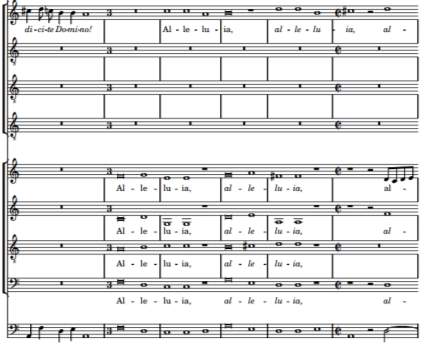
Example 1: Excerpt from In Ecclesiis (Gabrieli 2012: 2)
Giovanni applied the use of spatial placement with his musicians. He uses the two organ lofts and the floor as different areas in which groups of musicians are placed. This created an effect of ‘contrasting forces’, which inspired Baroque church music (Grout, Burkholder & Palisca 2014: 284).
Carl Maria von Weber used an offstage chorus in the Wolf’s Glen Scene (finale of Act II) of his opera Der Freischütz, a work premiered in 1821. According to Grout, Burkholder & Palisca (2014: 671), the use of the offstage chorus ‘reinforces the shadowy and supernatural elements of the plot’.
In Hector Berlioz’s Symphonie Fantastique, composed in 1830, an offstage oboe, together with an English horn, is used in order to imitate shepherds’ pipes (Grout, Burkholder & Palisca 2014: 634).
Berlioz also incorporates the idea of polyphonic music in his Grande Messe des Morts, Op. 5, composed in 1837. It includes four brass choirs which are placed at the North, South, East, and West of the place in which the requiem is performed. This displacement ‘encourage the audience to identify the musical perspective with an acoustical one, to perceive musical and actual space as analogues of each other’ (Cone 1980: 12). Example 2 shows an excerpt from the second movement of Dies Irae, where the four brass choirs are introduced. In the same example, one may also note the composer’s written instructions for spatial placement.
Charles Ives was considered as the pioneer of compositional techniques which were ignored in the nineteenth century, but developed by composers in the twentieth century. The Unanswered Question, composed in 1908, is one such example, in which he explores the use of his ‘collage technique’ (Varineau 2015).
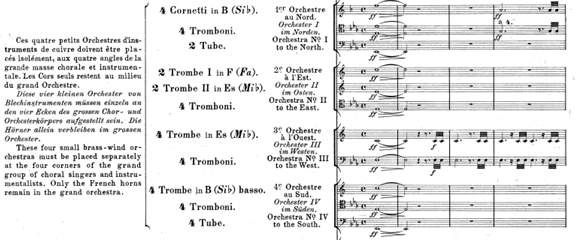
Example 2: Excerpt from the Second Movement of Dies Irae¸ from Berlioz’s Grande Messe des Morts, Op. 5 (Berlioz 1902: 19)
Three groups of musicians; string quartet, solo trumpet, and woodwind quartet, each play in tempos which are independent from each other. The strings are placed offstage, while the other two groups are placed on stage (Ford 2011: 17).
Karlheinz Stockhausen’s Gesang der Jünglinge, composed in 1956, is one of the first examples of electronic spatial music. The setup was of five loudspeakers, four on the walls, and one in the front. The audience could hear sound rotating around them, moving from one speaker to another, concluding that Stockhausen ‘incorporated the spatial dimension into the work’s serial composition process’ (Kurtz 1992: 84).
Gruppen, composed in 1955-57, reflects the same idea, using acoustic instruments instead of electronic ones. Three orchestras, each with a separate conductor, are placed in three different areas, with each group playing ‘in different tempi superimposed’ with each other, something which is considered new in Western music. For the variation of tempo, Stockhausen uses ‘chromatic scales of tempi corresponding to pitch, between MM=60 and MM=120, which is a ratio of 1:2, like an octave in the keyboard’ (Stockhausen 2010: 41). Figure 3 shows the seating arrangement of the first performance of the piece.
Iannis Xenakis’ works are known for their strong link between music and architecture. His approach to his works, both musical and architectural, are from a scientific and mathematical perspective. This link is mediated with another element which consists of two fields: ‘mathematical proportions’, and ‘the concept of space’ (Sterken 2007: 32).
Sven Sterken has referred to one of Xenakis’ conversations with Bálint András Varga regarding sound in physical space:
Space […] has the task of allowing sound to be heard properly. If, for instance, we seat four, five, six musicians performing a chamber piece close to one another the sound coming from one point is too thick, the instruments can’t be differentiated from one another. […] The sound will be much purer if we seat the musicians well apart. (Sterken 2007: 45)
Based on Xenakis’ statement, Sterken implies that ‘Space is thus called upon to “clarify” the musical discourse and serves the purpose of efficiency.’ (ibid.).
Terretektorh and Nomos Gamma are works in which the musicians are placed among the audience. Figure 4 and Figure 5 demonstrates the spatial distribution for Terretektorh and Nomos Gamma respectively.
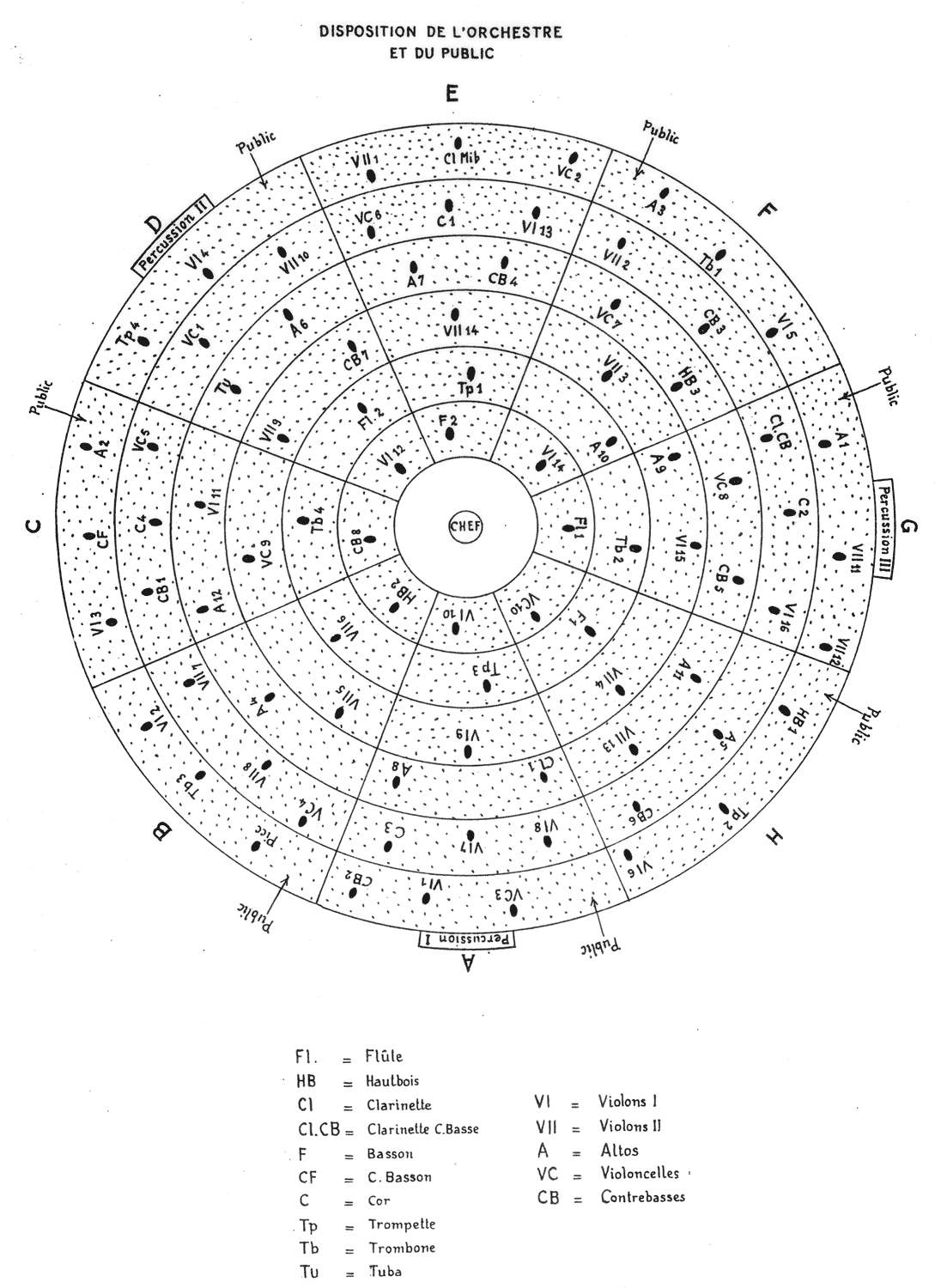
Figure 4: Seating Arrangement for Iannis Xenakis’ Terretektorh[2]
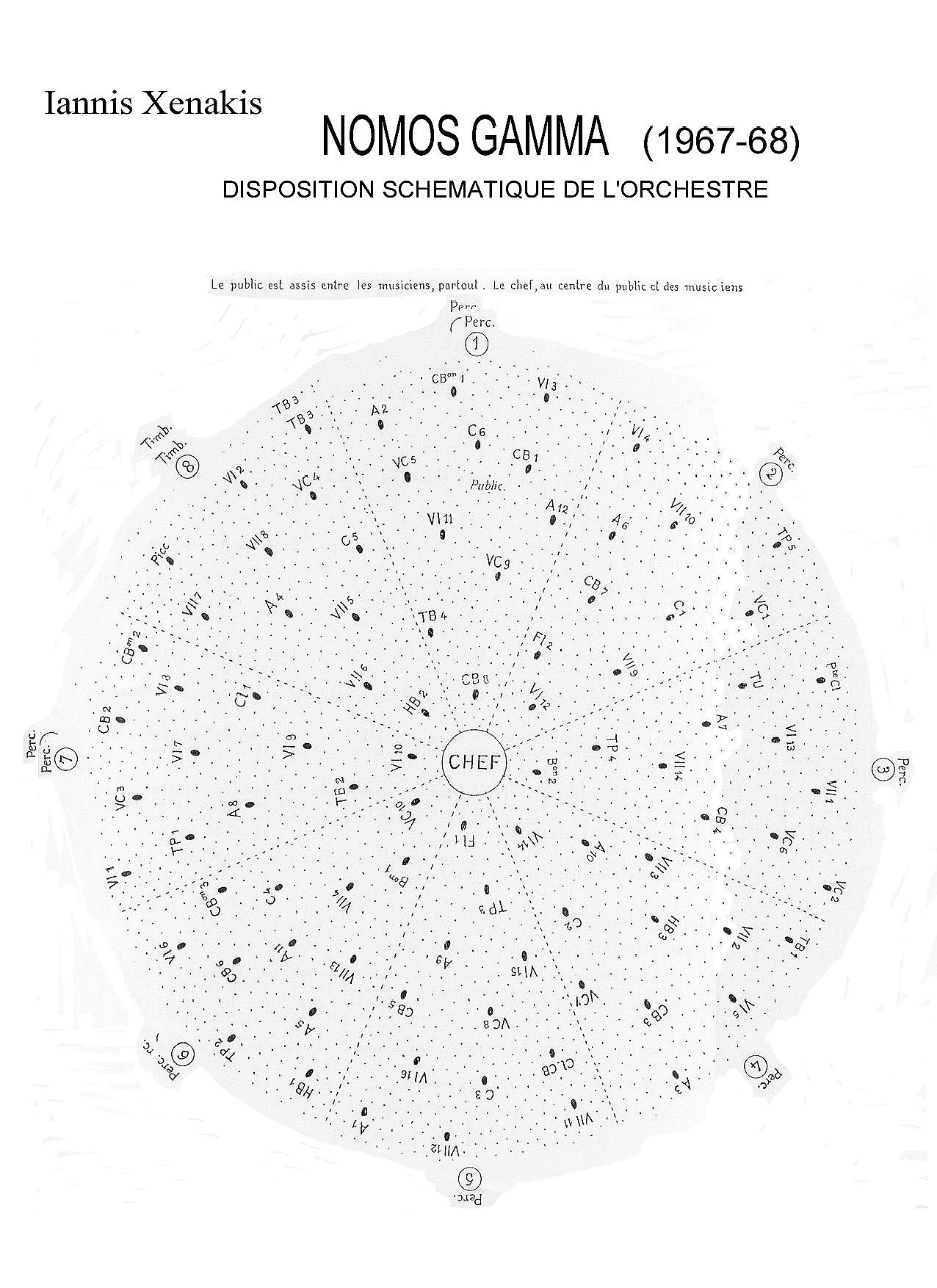
Figure 5: Seating Arrangement for Iannis Xenakis’ Nomos Gamma[3]
Similarly, Persephassa is a percussion sextet, in which the percussionists are situated around the audience. Figure 6 demonstrates how this is done, each letter representing a musician according to the letter corresponding to the score.
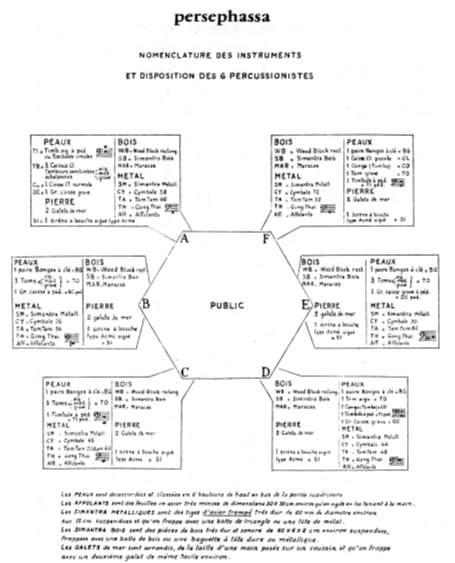
Figure 6: Seating Arrangement for Persephassa (Xenakis 1970: 40)
Sterken (2007: 47) stated that especially in Persephassa, Xenakis had introduced the idea of ‘continuous sound movement’. He explains it as ‘several layers of sound are simultaneously superimposed, each rotating in different directions and in its own tempo’. This created to what Sterken called ‘a multifaceted spatial polyphony’, in which he explains it ‘as if several independent space-time systems collide in the performance space’. In this manner, Xenakis uses spatial placement as a prominent compositional tool, in which it becomes ‘a fully fledged expressive parameter’ (Sterken 2007: 47). Additionally, Xenakis uses this tool in order ‘to achieve a greater compositional sophistication’. Example 3 demonstrates this idea.

Example 3: Excerpt from Persephassa (Xenakis 1970: 16)
Xenakis has also explored the notion of using spatial elements by electronic means. This was applied to his new idea of multimedia art which he called the polytope (polys = many, numerous; topos = place, space, territory, location), using sound and light as an articulation of ‘a domain of spatial complexity’. It was explained by Xenakis himself, that from what he created, he was ‘attracted by the idea of repeating on a lower level what Nature carries out on a grand scale. The notion of Nature covers not only the earth but also the universe.’ (cited by Harley 1998: 55).
One specific mention in which Xenakis had put this idea into life is the Philips Pavilion at the 1958 World Exposition in Brussels. Edgar Varese’s and Le Corbusier’s Poeme electronique was designed to complement Xenakis’ idea of his new art form, in which Varese composed the ‘music for tape projected from more than 400 loudspeakers’, and Le Corbusier designed the visual display of ‘slides and lights’, created independently from each other (Harley 1998: 56).
Henry Brant’s idea of space being ‘an essential aspect of musical composition’ is what his works are based on. The majority of his repertoire is based on spatial music. His works, however, was not given importance, as more focus was upon the European avant-garde composers such as Stockhausen (Harley 1997: 70).
Brant’s earliest work of this nature, Antiphony I, composed in 1953, demonstrates his belief. It is a piece for five groups; woodwinds, horns, muted brass, and strings, where the composer strictly states: ‘On no account may all five groups be placed together on the stage, or near the stage! This would go directly counter to the specific spatial-polyphonic concept of the music.’ The groups are not related strictly to each other, they do not follow the continuous layer of the music. Instead each group ‘enter on cues and proceed at their own speed’. Additionally, the spatial setting creates a contrast in ‘timbre, meter, key, texture, and motivic content between the five musical streams’ (Harley 1997: 70-71).
Aesthetics of Spatial Music
Hill & Paris (2014: 8-9) note that theatre acting may be viewed as an art form which develops according to the architecture in which the performance is taken place. They further add that ‘the theatre shapes us as much as we shape the theatre’.
One of Iannis Xenakis’ philosophy of the dispersion of musicians and audience is that ‘the audience no longer hears one single, homogenous sound; everyone literally hears the music from a different angle’. This means that one is consequently put in a position to listen analytically and actively. Xenakis puts it as the way how one perceives a building, interpreting music as ‘a matrix of ideas’, or ‘human intelligence in a particular state of crystallization’ (Sterken 2007: 49).
Xenakis’ view of music is not one to please an audience, but to be ‘a catalyst for reflection and a means of self-realization’ (Sterken 2007: 49-50). Sterken (ibid.) adds to his statement, saying that ‘music must be actively explored and discovered’. The argument is furthered by stating that Xenakis’ music is music for everyone, in which the listener experiences ‘the almost physical presence of the sound textures’.
Stockhausen (2010: 101-02) discussed about his exploration of sound localisation. He stated that ‘Musical space has been fixed in the Western tradition’, where one could only hear music coming from one direction. According to Stockhausen, the interest in being able to identify in which position the sound comes from, including from behind, was not important at the time. In the light of electronic music, the placement of speakers around a room allowed him to explore the movement of sound coming from different directions without having musicians objecting to moving physically while playing. He also introduced the idea of ‘relativity into the composition of movement and speed of sound in space’, which becomes as important as other compositional aspects such as pitch, duration, and melodic line.
Cage (1961: 12) discussed upon the ‘coexistance of dissimilars’. Referring to experimental music, he realises that it ‘is more clearly heard when the several loud-speakers or performers are separated in space rather than-grouped closely together’. Additionally, he adds that ‘the blending of several elements’ occurs at many central fusion points: ‘the ears of the listeners wherever they are’.
Harley (1997: 73-74) paraphrased Brant’s views on musical spatiality, taken from his article The Uses of Antiphonal Distribution and Polyphony of Tempi (1955), in four points, explained in Table 1.
| Point | Discussion |
| ‘Spatial separation clarifies the texture’ | A solution to avoid unisons which occur unconcernedly is to spread performers distantly from each other in the space. This occurs when the music contains layers of distinctive sonority schemes, ‘over the same octave range’. |
| ‘Separated groups are difficult to coordinate’ | Because of the distance amongst the performers, it is not possible to have ‘exact rhythmic simultaneities’. |
| ‘Spatial separation is equivalent to the separation of textures in pitch space (if performers are together on stage)’ | Having separated groups of performers gives the possibility to differentiate between the musical elements present, without having instrumental textures collide with each other. This allows ‘a greater complexity in the music’. |
| ‘Spatial arrangements must be planned exactly, but allow adjustments of details’ | Each different space used to perform the work may provide different limitations, therefore the placement of the audience and performers should be able to adjust itself as per to the situation. |
Table 1: Brant’s Views on Musical Spatiality (Harley 1997: 73-74)
Brant’s thoughts about space were written before Karlheinz Stockhausen’s and John Cage’s works, and therefore may have been of recognition to them. In the case of Stockhausen, he criticized Brant, as his approach to spatial music is ‘too theoretical’, and that ‘direction is the only spatial feature of sound worthy of compositional attention because it could be serialized’ (Harley 1997: 74).
In the case of Cage’s ideas, a similarity to what Brant calls ‘a total antiphony’ and Cage’s ‘co-existence of dissimilars’ is evident. Harley (1997: 75) suggests that this idea might be based on Charles Ives’ philosophy about spatial music, in which ‘the musical coexistence of spatially separated layers stimulates a change in perception by giving the audience the option to focus on individually selected musical strata’.
Ives (1933: 193) states that ‘the listener may choose which of these two rhythms he wishes to hold in his mind as primal […] the listener can choose to arrange in his mind the relation of the rhythmic, harmonic and other material’. Furthermore, Ives (ibid., 196) suggests that ‘in any music based to some extent on more than one or two rhythmic, melodic, harmonic schemes, the hearer has a rather active part to play’.
Conclusion
Original musical compositions, using space and place as a prominent composition tool, will be presented. Elements of sound, such as the acoustical properties and ambient sounds of places which the works are being performed, will be characterised in the works in various ways. This will be explored within the aesthetic nature of this type of work, such as sound movement and direction, allowing the exploration of spatial distribution of sound sources, while observing the presumed relationship between performer and audience. The compositions will ultimately be challenged to whether the work is defined as one of Wilkie’s or McAuley’s definitions of works of art which imply a common factor between the work and their place.
CHAPTER II
TOOLS USED
Introduction
The music composer is inspired partly by the elements, emotions, and experiences around or within the same composer. One should not underestimate the learnt skills through academic studies and the research of other composers which add on to these inspirations. However, numb and soundless are these inspirations and skills unless they are correctly versed and express through the necessary tools as a means of evidence. Thanks to technological advancement, what was ink and manuscript paper have transformed to many sofisticated tools used to express a piece of musical art in a variety of creative ways as possible. The materials and musical tools used to compose the compositions addressed in the next chapter are listed.
Technology
The fundamental tools used for the works listed in the following chapter were based upon the use of technological devices available. Sibelius 7, a music notation processor software, was the core working environment for Understanding, Missa Brevis Multas Partis, and Which Room?. This software allows the user to create, edit, listen and print music sheets.
For Fejn il-Baħar, a Digital Audio Workstation (DAW) called Ableton Live 9 Lite was used to arrange the soundscape. The software allows the user to record, edit, and manipulate audio recordings in a sequencer design, where one can control and layer individual audio or Musical Instrument Digital Interface (MIDI)[4] tracks to form one complete audio track. Virtual Studio Technology (VST) plugins were also part of the arrangement, consisting of software synthesizers and audio effect plugins which interact with the DAW.
Audio recordings were recorded using a Shure Beta 58A Dynamic vocal microphone. Its frequency response of 50 to 16,000 Hz and supercardioid polar pattern (Shure 2015) were sufficient to record the desired sounds for the soundscape.
For demonstration purposes, public domain audio field recordings of seascapes were used as an additional layer with Fejn il-Baħar. These additional recordings are not intended to be heard as the final piece, but rather to demonstrate the different experience for audiences when hearing the work at different places and times.
An audio interface, an RME Babyface, was used to connect the microphone to the laptop computer, interacting with the DAW. The laptop is equipped with an Intel Core i7 Central Processing Unit (CPU) and 4 Gigabytes of Random Access Memory (RAM). The audio was mixed using studio monitor headphones, the Audio Technica ATH-M40x. Figure 7 shows a diagram representing the hardware setup used for the compositional process.
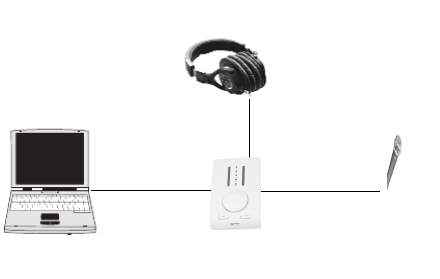
Space and Place
As discussed in the previous chapter, space and place is a prominent compositional tool used in all the compositions. Sound source placement is essential to employ sound direction. All works have specific instructions which should be followed in order to appreciate the aesthetic elements of each work.
With exception to Fejn il-Baħar, all works have their respective spatial diagram, giving an idea on how each perfomer should be positioned within a space. As for the piece Understanding, each individual instrumentalist is placed at specific points in a space, while having the audience surrounding them. For Missa Brevis Multas Partis, the two choirs are spread along the length of a space, surrounding an audience. Which Room? places in position two pianos in two opposing rooms that lead to a shared space such as a hall, corridor, or another room. For Fejn il-Baħar, the personal space between the headphones and the listener’s ears is opened to the sounds of the surrounding environment; that of the sea.
These works also give importance to the acoustical properties of a site. Understanding should be performed at sites with dry acoustics. For Missa Brevis Multas Partis, the site should have wet acoustics. The sound coming from both rooms in Which Room? should not be muffled by any obstructions at the door. The headphones for Fejn il-Baħar should not be noise cancelling. This will allow the live sounds of the environment to be heard. This also implies that the volume should not be overpowering to the live sounds of the environment and is to be kept at an appropriate level to allow more effectiveness and appreciation on the listener.
Musical Elements
Melody writing was important for every piece. A melodic motive was developed with variations for Understanding. The main melody for Sanctus in Missa Brevis Multas Partis was based on a mixture of modes, which eventually became the starting point for the other melodies of Kyrie and Agnus Dei. For Fejn il-Baħar, sound clips were treated as motives, varied in pitch and speed.
Pandiatonic harmony was used for Missa Brevis Multas Partis, as well as for Which Room?. Rhythm was an essential part for Which Room?, where Latin rhythms were inspirations to the changes in time signatures. Sound texture was the core element for Understanding and Fejn il-Baħar. The combination of each instrument, or audio clip, instils colour and depth in the music.
CHAPTER III
COMPOSITIONAL PROCESS
Soundscape: Fejn il-Baħar
Introduction
Translated in English By the Sea from Maltese, Fejn il-Baħar is a soundscape in which the title itself suggests for the piece to be performed at seaside locations. Inspired by the ‘extra live’ element of the theatrical performance in Out of Water (2014) by Curious, the work is an acousmatic and electronic musical work for tape, heard through standard stereo headphones, and live ambient sound found by the sea.
Objective
The main objective of this work is to explore the coherent relationship between live ambient sounds and tape. The purpose of this work is to allow the audience member to appreciate sounds which are not conventionally considered as music, and apply it to a soundscape ideology.
Method
According to Schafer (1993: 7), a soundscape is ‘any acoustic field of study’. Examples include musical works, a radio programme, or an acoustic environment. Features that are significant in a soundscape are defined in Table 2.
| Feature of a Soundscape | Definition |
| Keynote sound | The ‘fundamental tone’. It gives definition to the soundscape. All other sounds are modulated around this tone. |
| Signal | Foreground sounds which are listened to consiously. |
| Soundmark | Sound ‘which is unique or possesses qualities which make it specially regarded or noted by the people in that community’. |
Table 2: Features of a Soundscape, according to Schafer (1993: 9-10)
Fejn il-Baħar’s keynote sound is the live ambient sounds by the sea. This is complemented with white and brown noise, which can be associated with the sea. All other sounds, including piano strings, human breaths, hair comb, paper crumbling, caster chair, keyboard typing, and electronic sounds produced with AIR Hybrid 3, a VST audio synthesizer, are considered as signal sounds within the soundscape.
The tape recording consists of a sound clip of hand plucking and hits of piano strings, which was recorded, copied and arranged to different tracks, and manipulated in pitch and speed. This arrangement is considered as the main theme of the recording. Figure 8 demonstrates this arrangement.
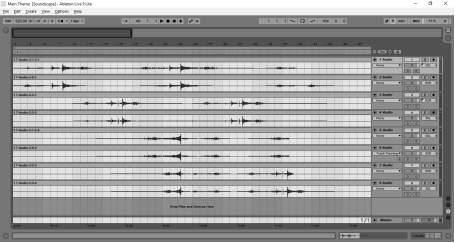
Figure 8: Fejn il-Baħar – Main Theme
The work may be divided into three sections: the Introduction, the Climax, and the Recapitulation. Four Ableton Live Sets were set up: one comprising solely the main theme and an ambient swish using manipulated piano recordings, another comprising the Introduction (Figure 9), another comprising of the explosion sound in the Climax, and the fourth with all sections included (Figure 10). The reason behind this is mainly because of the limitations of eight tracks in the Ableton Live Lite verision. However, this helped with the processing power required for runing plugins and audio tracks, while aiding the workflow by arranging each section independently.
The majority of the sounds were recorded on mono tracks, using a Shure Beta 58A microphone. The main intention for this is to to create effective movement with stereo panning. Two Shure Beta 58A microphones were used for stereo recording of the sound of a keyboard typing, to have the actual stereo field of the sound extracted live.
Air Hybrid 3 was used for the explosion sound in the Climax section. A total of four preset sounds were used, recorded directly from the VST instrument to the DAW as audio tracks. This allows the possibility of creating new sounds by changing parameters within the VST instrument while recording. The use of a three-band reverb with control of low, mid and hi-decay gives the sounds used in most tracks a sense of depth in sound space (Figure 11).
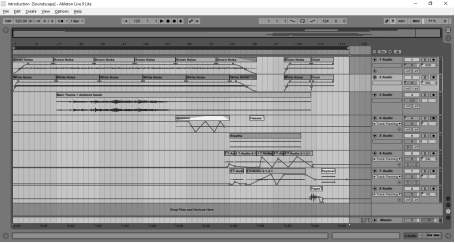
Figure 9: Fejn il-Baħar – Introduction
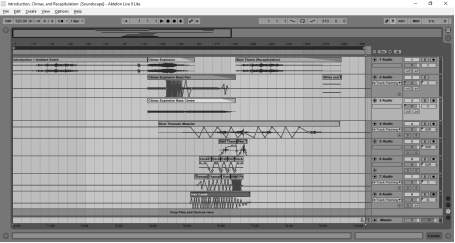
Figure 10: Fejn il-Baħar – Introduction, Climax, and Recapitulation

Figure 11: Fejn il-Baħar – Climax explosion sound , Air Hybrid 3, and 3-Band Reverb
The Soundscape
John Cage was known as one of the most controversial musical composers in his time. He performed one of his late works Water Music live on air during a USA national television programme I’ve Got a Secret in 1960. While interviewing him before his performance, the presenter asked Cage whether the work he was about to perform is considered as music. His reply was the following: ‘I consider music the production of sound, and since in the piece you will hear I produce sounds, I would call it music.’ (New York Public Library 1960).[5] This is also demonstrated in his essay The Future of Music: Credo, found in his book Silence. The essay consists of statements, written in capital letters, with an explanation of each statement below them. These statements when put together form a creed of what he believes the future of music will be.
I BELIEVE THAT THE USE OF NOISE […] TO MAKE MUSIC […] WILL CONTINUE AND INCREASE UNTIL WE REACH A MUSIC PRODUCED THROUGH THE AID OF ELECTRICAL INSTRUMENTS […] WHICH WILL MAKE AVAILABLE FOR MUSICAL PURPOSES ANY AND ALL SOUNDS THAT CAN BE HEARD. PHOTOELECTIUC, FILM, AND MECHANICAL MEDIUMS FOB THE SYHTHETIC PRODUCTION OF MUSIC […] WILL BE EXPLORED, WHEREAS, IN THE PAST, THE POINT OF DISAGREEMENT HAS BEEN BETWEEN DISSONANCE AND CONSONANCE, IT WILL BE. IN THE IMMEDIATE FUTURE, BETWEEN NOISE AND SO-CALLED MUSICAL SOUNDS. […] THE PRESENT METHODS OF WRITING MUSIC, PRINCIPALLY THOSE WHICH EMPLOY HARMONY AND ITS REFERENCE TO PARTICULAR STEPS IN THE FIELD OF SOUND, WILL BE INADEQUATE FOR THE COMPOSER. WHO WILL BE FACED WITH THE ENTIRE FIELD OF SOUND. […] NEW METHODS WILL BE DISCOVERED, BEARING A DEFINITE RELATION TO SCHOENBERG’S TWELVE-TONE SYSTEM […] AND PRESENT METHODS OF WRITING PERCUSSION MUSIC […] AND ANY OTHER METHODS WHICH ARE FREE FROM THE CONCEPT OF A FUNDAMENTAL TONE. […] THE PRINCIPLE OF FORM WILL BE OUR ONLY CONSTANT CONNECTION WITH THE PAST. ALTHOUGH THE CHEAT FORM OF THE FUTURE WILL NOT BE AS IT WAS IN THE PAST, AT ONE TIME THE FUGUE AND AT ANOTHER THE SONATA, IT WILL BE RELATED TO THESE AS THEY ARE TO EACH OTHER: […] THROUGH THE PRINCIPLE OF ORGANIZATION OR MANS COMMON ABILITY TO THINK. (Cage 1961: 3-6).
Regarding noise, Cage refers to it as ‘Wherever we are, what we hear is mostly noise. When we ignore it, it disturbs us. When we listen to it, we find it fascinating.’ (Cage 1961: 3). Schafer (1969: 1) once wrote to Cage asking what is the definition of music. Cage replied ‘Music is sounds, sounds around us whether we’re in or out of concert halls: cf. Thoreau.’, whereby the reference is to the book Walden, by the philosopher Henry David Thoreau. Schafer explains the Thoreau reference as ‘where the author experiences in the sounds and sights of nature an inexhaustible entertainment.’ Schafer (ibid.) also refered to Cage’s music, where it ‘encourages the street noises to intersect his compositions’ while ventilating ‘the art of music with fresh and seemingly shapeless concepts’.
Sound Appreciation
The appreciation of what may be conisered as noise which intersects a music composition, is what makes Fejn il-Baħar what it is. One may explore the different listening experiences of this work when performed in different seaside locations around the world. Factors which affect the different sounds include the season, time of day, weather, physical properties attributed to the location (sand, rocks, pebbles, and or algae), and any other noise which happens to be there.[6] Compared once again with Out of Water, ‘site reveals and withholds its own narrative, simultaneously fixed and fluid, choreographed and constantly changing, as weather, environment and happenings of everyday life play their part’ (Hill & Paris 2014: 98).
Listening to the tape recording anywhere else other than seaside locations will not appreciate the work the same way it was perceived. Similar to Serra’s Tilted Arc, and referring to Kaye’s statement, moving the work somewhere else will ‘make it something else’ (2006: 2).
Audience-Performer Relationship and Considerations of Space
One should also not forget Boal’s and Schechner’s suggestion regarding each performance being unique even with the same performers, including the interactivity and reception of an audience (Schechner 2013: vi, 30). In the case of Fejn il-Baħar, the performers can be compared to the live ambient sounds, and the music player in which the tape recording is stored and played through stereo headphones. The audience is the listener with the headphones. The extra live element, together with the different locations, implies an unpredictable and unique listening experience every time the soundscape is performed.
In Digital Proxemics, McArthur (2016: 44) describes the use of headphones, along with the mobile phone, as ‘a non-verbal sign that we do not want to be bothered’. This is considered through proxemics as a ‘sociofugal interpretation of digital technology and personal space’. This however, challenges the scope of this soundscape. While the listener is enclosed within his personal space to listen through headphones, the listener is also open to the sound which occurs outside of the sociofugal environment of the headphones. This opens to a proxemic dimension which is both public and personal, transferring the audience to different spaces, as suggested by Hill & Paris (2014: 98). It is hence the reason why the audience is instructed not to use noise cancellation headphones, as the main intention for the work is to explore this proxemic notion. This notion is similar to what an audience member observed in Out of Water (Hill & Paris 2014: 108-109).
Choral Work: Missa Brevis Multas Partis
Introduction
According to the Online Encyclopedia Brittanica, the Ordinary is a collection of texts found during a Roman Catholic or mass which do not change. These texts consist of the Kyrie, Gloria, Credo, Sanctus and Benedictus, and Agnus Dei. In a musical setting, a mass with all texts is known as‘Mass’, while in the case of having some of these texts ommitted, or has a moderate time duration, is considered as Missa brevis (Herbermann 1911: 2).
Objective
Translated from Latin meaning ‘Short Mass from Different Directions’, Missa Brevis Multas Partis is a short mass for two SATB acapella choirs dispersed around an audience. The work consists of Kyrie, Sanctus (including the Benedictus)and Agnus Dei. The main objective is to expand on the idea of separated choirs, dating back from the Venetian times. Rather than having two choirs grouped together on two sides, each vocal section from each choir is spread out in groups along the sides of a site, surrounding an audience. The purpose for this objective is to create a sense of sound localisation for the audience, where one can locate different vocal ranges and textures coming from different directions in a space.
Method
The main melody for Sanctus, based on the mixolydian mode, was composed prior Kyrie and Agnus Dei. For the latter two, figures and melodic ideas were borrowed from Sanctus, to instil a unified work. The main link between all parts of the mass is a rhythmic figure, Fig. 1, as seen in Example 4.
Example 4: Fig. 1 for Missa Brevis Multas Partis
Example 5, Example 6, and Example 7 show the implementation of Fig. 1 in all works within the mass.

Example 5: Excerpt from Kyrie (bars 1-5)

Example 6: Excerpt from Sanctus (bars 1-6)

Example 7: Excerpt from Agnus Dei (bars 1-7)
A direct melodic cross-reference is seen in the main melody of Agnus Dei (Example 8), which borrows the melodic idea from bars 12-20 of Sanctus (Example 9).

Example 8: Main Melody from Agnus Dei (bars 1-7)

Example 9: Melody from Sanctus (bars 12-17)
The harmonic structure is based upon pandiatonic harmony, where ‘all seven degrees of the diatonic scale are used freely in democratic equality’ (Kostelanetz 2013: 465). Some elements of chromaticism is also present.
The stylistic nature of the piece allows moments for all voices to infuse together, building up from points of different spatial directions. In Kyrie, the piece is introduced by Soprano I, Alto II, and Bass I. Tenor I is introduced in bar 3, followed by Soprano II, Alto I, and Bass II after two beats, and Tenor II after 3 beats, slowly building up to an infused climatic sound in bar 5. The same idea is repeated in bars 14-18.
For Sanctus, the forementioned concept is introduced in bars 19-26 (and similarly in bars 37-44). Each vocal section, starting from Soprano I, the text Hosanna moving in succession for every three quaver beats. From bar 23 and 41, while the rest of the sections continue this flow, a new note introduces the climatic final clustered chord. This is followed in succession for every three quaver beats by all other sections, with exception to Bass II which is introduced together with Bass I at the climatic point in bar 26 and 44.
In Agnus Dei, the piece is introduced by Soprano I, Alto II, Tenor I, and Bass II. In bar 8, Soprano II, Alto I, Tenor II, and Bass I, respond to the first verse in a varied harmonic arrangement. Bar 14 reintroduces the first four vocal sections together with the latter four.
Considerations of Space and Sound
The work was percieved to be performed in a traditional church or cathedral with wet acoustics. Wet acoustics are essential since it is believed that the polyphonic texture of the work would unify the sound. However, it is also important to note that a mass may occur in any other space outside the church. In conclusion, provided that the spatial layout is respected and contain wet acoustics, this piece may be performed in any location where logistically possible.
Coordination between the vocal groups may be difficult, as suggested by Brant (cited by Harley 1997: 73-74). In order to aid this, each group should be led by their respective leader, while ensuring that all these groups can communicate with each other. One may also apply theatre practices, such as Lecoq’s and Gaulier’s application of complicité amongst performers, implying ‘a shared belief which depends upon intense awareness and mutual understanding’ (Callery 2001: 88). Eye contact, and ‘heightened sensory awareness of space’ in conjunction to rhythm and timing are important within a group of performers, as well as non-verbal communcation. One may find various exercises to utilise these factors. The same quoted book by Callery (2001) already give some examples, and similarly Boal’s book Games for Actors and Non-Actors (2002). This collection of exercises could be of good practice for the leaders and choir members to achieve complicité amongst themselves.
Audience-Performer Relationship
Stockhausen’s philosophy of sound localisation (2010: 101-02) reflects the aesthetic dimension of this piece. The performer and audience member will not hear sound coming from one direction, but from several directions in a space. What makes this work different from Stockhausen’s philosphy is that each sound source is restricted to each vocal group’s respective vocal range and texture.
Orchestral Work: Understanding
Introduction
Stockhausen’s studies of sound localisation (2010: 101-02) was a practice also utilised by Xenakis through multispeaker sound technology, such as the multispeaker setup of the Philips Pavillion. He further developed it to be used for traditional instruments, with works such as Eonta in 1964, and Oresteïa in 1966 (Harley 2004: 46). Terretektorh, composed between 1965-66, is a work for 88 musicians scattered amongst an audience, commissioned and premiered in the 1966 edition of the Royan Festival. The title itself means ‘construction by action’, which refers to Xenakis’ concept of continuous sound movement (ibid.).
Objective
The main objective of the work Understanding is to explore Xenakis’ compositional methods to achieve ‘continuous sound movement’. Inspired from his work Terretektorh, this work is an attempt to repurpose his ideas while modifying some of his parameters in the work presented in this study. The objective is reached by studying Xenakis’ techniques used in his handwritten score and spatial setup, while applying it to a minimalist musical style.
Instrumentation
Understanding is a work for an orchestra of 56 musicians. Instruments include two Flutes, two Oboes, two Clarinets in Bb, two Bassoons, four Horns in F, two Trumpets in C, four Trombones, two Tubas, four Percussions (Timpani, Xylophone), sixteen Violins, eight Violas, four Cellos, and four Contrabasses. Compared with Xenakis’ orchestral works of this nature, the number of musicians for Understanding is significantly less.
Method
The first approach to the compositional process was to study the written score and the spatial distribution of Xenakis’ Terretektorh. From Xenakis’ score, ideas were borrowed, such as the shifted long chords and notes to create the effect of a continuous moving sound. The continuous note of one instrument is repeated and shifted a few beats after the other, as shown in Example 10. For greater effect, each instrument plays one note starting from p, gradually increasing to f and then slowly decreases back to p.
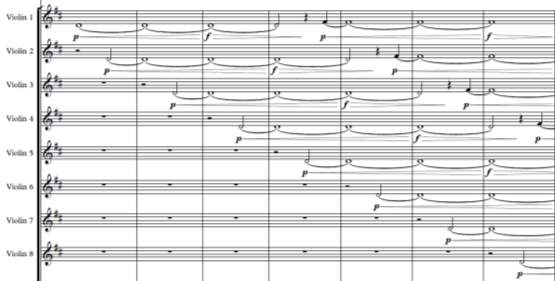
Example 10: Excerpt from the score Understanding (bars 1-7), demonstrating the effect of a continuous moving sound on the Violins
A rhythmic figure (Fig. 1), preceded with a long tied note, was stochastically distributed between instruments at different points in the score to create interest. At certain points, the figure is played simultaneously with different instruments. This is illustrated in Example 11.
Example 11: Excerpt from the score Understanding (bars 14-21)
The main motive of the piece, shown in Example 12, was also created to imply interest to the music (Motive a). Example 13 is an augmented and retrograded version of the same motive, with the last note prolonged (Motive a1). Motive a2 is a variation of Motive a1 (Example 14). For all motives, the pitches are varied throughout the score, and played by different instruments in a call and response manner. This gives the piece a variant melodic texture throughout.

Example 12: Motive a (Understanding)

Example 13: Motive a1 (Understanding)

Example 14: Motive a2 (Understanding)
Xenakis’ spatial distribution diagram of Terretektorh was also observed, how the instruments are placed, and how the music translates to the sound movement he envisioned. For Understanding, sketches for a new spatial distribution diagram were being drawn while envisioning how the sound will move within the space. Contrary to Xenakis, the musicians are not distributed into collective groups, where sound moves collectively from one group to another. Each orchestral section is structured in spiral and curved groups, where the sound would move from one instrument to another within the space. Appendix B (pp. 53-56) shows these spiral and curved groups within the spatial distribution diagram, according to every orchestral section. All musicians face towards the conductor, situated in the centre. All sections take diverse paths where sound moves from one instrument to another.
For the String section, the Violins and Violas are divided in two groups. Each group of violins consists of eight musicians, while four musicians are assigned for each of the Viola groups. These groups are placed in spirals opposite to each other. The music in the score indicate that the opposing groups are identical to each other, resulting in having the sound coming from two opposing ends of the space. This will lead to a one line musical strand, which consists of Violoncellos and Double Basses.
Considerations of Space and Sound
Although the spatial placement is clearly indicated in Xenakis’ works, no evidence was found through reaserch which shows a consideration of the natural sound of an acoustic space. Unless new evidence show otherwise, this issue apparently did not concern the composer.
The spatial setup of the work naturally requires venues large enough which will allow all musicians and audience members to be seated among each other. A recent performance of Terretektorh in 2011 was performed by the hr-Sinfonieorchester, a radio orchestra of the German public broadcaster of Hesse, Hessiker Rundfunk. It was performed as part of the Cresc… Biennale für Moderne Musik, at the Böllenfalltorhalle, a sports hall in Darmstadt, Germany. [7] Here, much of the floor space measuring 20m x 40m has been used[8] where such venue, if not treated, can produce a wet sound.
For Understanding, the natural sound of an acoustic space was considered. The main reason is that although sound localisation is possible in larger spaces, its authenticity will be lost. Large venues which are acoustically treated to achieve a dry sound are few. Therefore, the decision of reducing the number of musicians would allow the possibility of finding smaller open spaces which are treated acoustically to produce a dry sound in the space. Moreover, a small traditional orchestra would be able produce this work with their musicians without outsourcing many others.
Audience-Performer Relationship
This work reflects directly on Xenakis’ philosophy of the dispersion of musicians and audience (Sterken 2007: 49-50). Each performer and audience member will experience this work differently. The sound of an instrument will be heard more prominently to a performer or audience member seated at proximity. This in itself shows the aesthetic dimension of the piece.
Work for Two Pianos: Which Room?
Introduction
Cage’s philosophy of ‘coexistance of dissimilars’ (1961: 12) refers to Ives’ idea of giving an audience ‘the option to focus on individually selected musical strata’ (cited by Harley 1997: 75). One may arguably suggest that to achieve interest with fewer sound sources, more attention should be given to the musical material itself. This does not suggest that musical material should be disregarded when a composer has more than one sound source.
Objective
The main objective is to perceive the notion when two sound sources with identical textures come from separate rooms, and are amalgamated together in a central one. This allows the possibility for an audience to have a different perception of listening to live music in a space. The purpose is to perceive the relationship between a live audience and performers without visually seeing the performers themselves.
Method
Which Room? is a work for two pianos, each separated in opposing rooms. The audience is placed at a corridor or hall where these two rooms are led from. The music between both performers is composed to complement the spatial setup envisioned.
The melody and accompaniment is shared between the two players. In some instances, the melody is played by Piano 1 (Left) and accompanied by Piano 2 (Right), while in others, the roles are reversed. In some instances, both pianos accompany each other. The introduction section, bars 1-4, is one example of many where all these feature, as shown in Example 15. This should hopefully allow the audience members to engage with the piece in a spatial dimension, where audience members would actively search in which direction the melody and accompaniment is coming from.
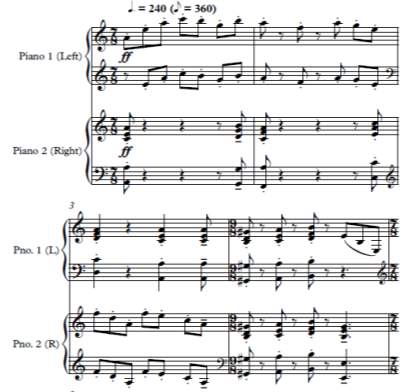
Example 15: Excerpt from Which Room? (bars1-4)
The rhythm is influenced from Salsa music, based upon what Peñalosa terms as an ‘onbeat/offbeat’ figure (cited by Moore 2011: 32). In this work, the irregular time signature of seven quaver beats in a bar (7/8) complements this concept without notating it in cut-time. This is demonstrated in Example 16. Unlike in Salsa music, the rhythm is not repeated through an ostinato, as it is interrupted at several points in the work with the use of time signature changes.

Example 16: Rhythm for Which Room?
Considerations of Space and Sound
Two pianos are to be placed in opposing rooms, leading into a corridor or hall where the audience is situated. The audience should be able to identify where sound is coming from, therefore it is important that at least the acoustics of the two rooms should be similar to each other, in order to avoid any variation of sound.
Since the corridor or hall may have a different acoustical feature from the rooms, the pianists might be out of synchronization with each other. Therefore, it is suggested that the performers should use in-ear monitors, where they can hear each other as if they are in the same room together.
It is also important that no obstructions are in both doorways. This is in order to have visual communication between the performers. Also, any object obstructing the doorway may alter the final acoustical sound.
Audience-Performer Relationship
As mentioned before, the audience and performer do not have a visual relationship between them. However, if the audience member understands the concept of sound direction, it should allow the listener to appreciate the work, creating a relationship with the music. One can perceive this relationship when hearing music through headphones. However, since the music is live, the experience is different than simply listening to a recording of the work.
CHAPTER IV
CONCLUSION
Supporting Boal’s statement (Schechner 2013: vi), in conjunction to Xenakis, Stockhausen, Cage, Ives, and Brant’s theories of music in space, each performance of every work will not be the same for all audience members. This in itself is aesthetically pleasing, as art is seen differently by different people. These works prove to make this idea more determined.
One may categorise all the works presented with the first category of new found performance spaces as defined by McAuley (2005: 31), where ‘certain formal and aesthetic qualities’ are necessary to produce a work. This however does not have a specific terminology which one could identify these types of works. It would be recommended that a new term could be labelled. Using space as a word implies an abstract concept, whereas site or place is something which is more specific. Therefore one must be careful which words should be chosen to form a definition.
The aesthetic beauty of the works presented in the study were an inspiration to the composer. Using space and place as a prominent compositional tool gave an opportunity to challenge traditional performance practices, and give an opportunity to create diverse ways of appreciating music. Such works augur to leave an impression on the audience who experience this work.
APPENDICES
Appendix A
Table 3: The Eight Categories of Performance (Schechner 2013: 31-34)
| Category | Discussion | |
| 1. | In everyday life – cooking, socializing, “just living” | ‘The non-stage roles of ordinary life are many, ranging from the highly formalized performances of government and religious leaders to the semi-fixed roles of the professions, to the more easy-going improvisations of informal interactions. […]
[…] There is no such thing as unperformed or naturally occurring real life. The object of the actor’s “real life study” is also performing, though she may not be fully aware that her behavior is codified. All behavior is “twice-behaved,” made up of new combinations of previously enacted doings. A wholly conscious performer, if such a person exists, is one who twice-performs twice-behaved behaviors.’ (Schechner 2013: 220). |
| 2. | In the arts | ‘The arts take as their subjects materials from everywhat and everywhere.’ (Schechner 2013: 31).
‘What may be considered as art depends on the history and culture may be the contrary in others, and would be considered as sacred rituals.’ (ibid., 32). ‘An actor on the stage, a shaman, or someone in trance stands for or is taken over by someone else or something else. This “else” may be a character in a drama, a demon, a god, or a pot.’ (Schechner 2013: 220). |
| 3. | In sports and other popular entertainments | ‘…some sports are close to fine arts. Gymnastics, figure skating, and high diving are recognized by the Olympics. But there are no quantitative ways to determine winners […] these “aesthetic athletes” are judged qualitatively on the basis of “form” and “difficulty.” Their performances are more like dancing than competitions of speed or strength. But with the widespread use of slowmotion photography and replay, even “brute sports” like football, wrestling, and boxing yield an aesthetic dimension that is more apparent in the re-viewing than in the swift, tumultuous action itself.’ (Schechner 2013: 33). |
| 4. | In business | ‘to perform means doing a job efficiently with maximum productivity’ (ibid., 34). |
| 5. | In technology | ‘The use of technology in rituals and activities ‘sometimes subtly and sometimes more obviously changes the ritual. Electric lighting, microphones, and more recently the use of the internet have all resulted in changes in the performance of rituals.’ (Schechner 2013: 81). |
| 6. | In sex | ‘Sexual performance also invokes meanings drawn from the arts and sports. Consider the range of meanings attached to the phrases “performing sex,” “How did s/he perform in bed?” and being a “sexual performer.” The first refers to the act in itself and the second to how well one “does it,” while the third implies an element of either going to extremes or of pretending, of putting on a show and therefore maybe not really doing it at all.’ (Schechner 2013: 34). |
| 7. | In ritual – sacred and secular | ‘The ritual objects of one culture or one historical period become the artworks of other cultures or periods.’ (ibid., 32). |
| 8. | In play | ‘Play is often an orderly sequence of actions performed in specified places for known durations of time […]. One group of play theorists sees playing as the foundation of human culture, art and religion especially. Others regard play as an ambivalent activity both supporting and subverting social structures and arrangements.’ (Schechner 2013: 121). |
Appendix B
Paths of Sound Movement within each Orchestra Section in Understanding
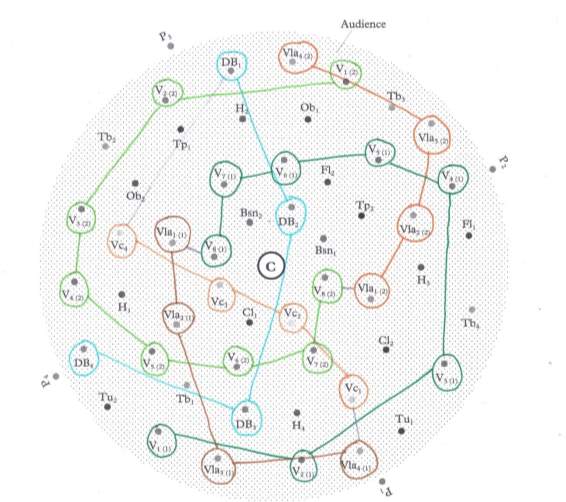

Figure 12: Spatial Distribution Diagram for Understanding: Strings
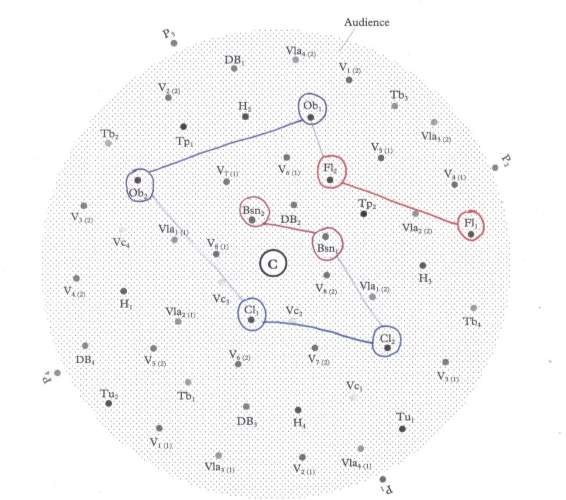

Figure 13: Spatial Distribution Diagram for Understanding: Woodwinds
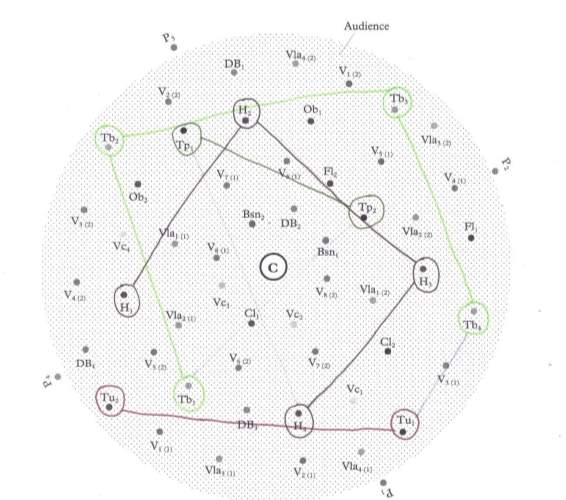

Figure 14: Spatial Distribution Diagram for Understanding: Brass
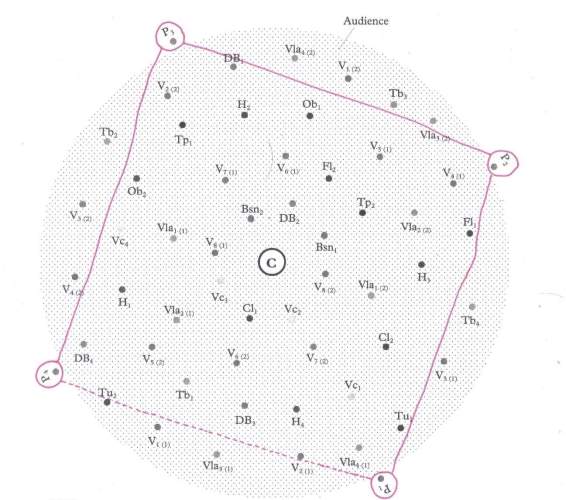

Figure 15: Spatial Distribution Diagram for Understanding: Percussion
WORKS CITED
Books
Beranek, Leo L., and T. Mellow. 2012. Acoustics: Sound Fields and Transducers (Cambridge, Massachusetts: Academic Press)
Cage, John. 1961. Silence: Lectures and Writings (Middletown, CT: Wesleyan University Press)
Callery, Dymphna. 2001. Through the Body: A Practical Guide to Physical Theatre (London & New York: Routledge)
Ford, Andrew. 2011. Illegal Harmonies: Music in the Modern Age (Collingwood: Black Inc.)
Grout, D. J., J. P. Burkholder, and C. V. Palisca. 2014. A History of Western Music, 9th edn. (New York & London: W. W. Norton & Company)
Harley, James. 2004. Xenakis: His Life in Music (New York/London: Routledge)
Hill, L., and H. Paris. 2014. Performing Proximity: Curious Intimacies, (London: Palgrave Macmillan)
Herbermann, Charles G. et al (ed.). 1911. The Catholic Encyclopedia, Volume X. (New York: Robert Appleton Company)
Kaye, Nick. 2006. Site-Specific Art: Performance, Place and Documentation, eBook edn(Taylor and Francis eLibrary)
Kostelanetz, Richard. 2013. A Dictionary of the Avant-Gardes (London & New York: Routledge)
Kurtz, Michael. 1992. Stockhausen: A Biography, translation by Richard Toop (London: Faber and Faber)
McArthur, John A. 2016. Digital Proxemics: How Technology Shapes the Ways We Move, eBook (Bern: Peter Lang)
Moore, Kevin. 2011. Understanding Clave and Clave Changes. (Santa Cruz, CA: Moore Music/Timba.com)
Pakhira, Malay K. 2010. Computer Graphics, Multimedia and Animation,2nd edn (New Delhi: PHI Learning Private Ltd.)
Peters, R. J., Smith, B. J., and M. Hollins. 2013. Acoustics and Noise Control (London & New York: Routledge)
Schafer, Richard M. 1969. The New Soundscape: A Handbook for the Modern Music Teacher (Ontario: BMI Canada)
—. 1993. The Soundscape: Our Sonic Environment and the Tuning of the World (Rochester, Vermont.: Inner Traditions | Bear & Co.)
Schechner, Richard. 2013. Performance Studies: An Introduction. 3rd edn (London: Routledge)
Senie, Harriet. 2002. The Tilted Arc Controversy: dangerous precedent? (Minneapolis, MN: University of Minnesota Press)
Stockhausen, Karlheinz. 2010. Stockhausen on Music, reprint, compiled by Robin Maconie (London: Boyars)
Tuan, Yi-Fu. 1977. Space and Place: The Perspective of Experience (Minneapolis, MN: University of Minnesota Press)
Online Sources
ArtsAdmin. 2015. Out of Water <https://www.artsadmin.co.uk/media/documents/promoters/Out%20of%20Water_pack.pdf> [accessed 12 November 2016]
Varineau, John P. 2015. The Unanswered Question <https://www.richmondsymphony.com/wp/wp-content/uploads/2015/02/Notes_Tchaikovsky_web.pdf> [accessed 04 December 2016]
Shure. 2015. Product Specifications – Beta® 58A Supercardioid Dynamic Vocal Microphone <http://cdn.shure.com/specification_sheet/upload/123/beta58a-specification-sheet-english.pdf> [accessed 20 May 2017]
Journal Articles
Cone, Edward T. 1980. ‘Berlioz’s Divine Comedy: The Grande Messe des morts’ 19th-Century Music, 4(1): 3-16
Hall, Edward T. 1968. ‘Proxemics’, Current Anthropology, 9(2/3): 83-108
Harley, Maria A. 1997. ‘An American in Space: Henry Brant’s “Spatial Music”’, American Music, 15(1): 70-92
—. 1998. ‘Music of Sound and Light: Xenakis’s Polytopes’, Leonardo, 31(1): 55-65
Ives, Charles. 1933. ‘Music and its Future’, in Henry Cowell (ed.) American Composers on American Music,(Palo Alto, CA: Stanford University Press), pp.191-198
McAuley, Gay. 2005. ‘Site-specific Performance: Place, Memory and the Creative Agency of the Spectator’, Arts: The Journal of the Sydney University Arts Association, 27: 27-51.
Madrid, Alejandro L. 2009. ‘Why Music and Performance Studies? Why Now? : An Introduction to the Special Issue’ Trans. Revista Transcultural de Música, 13: 1-8 <http://www.sibetrans.com/trans/articulo/1/why-music-and-performance-studies-why-now-an-introduction-to-the-special-issue> [accessed 29 July 2016]
Sterken, S. 2007. ‘Music as an Art of Space: Interactions between Music and Architecture in the Work of Iannis Xenakis’, in Mikesch W. Muecke, and Miriam S. Zach (ed.) Resonance: Essays on the Intersection of Music and Architecture: pp. 21-52
Wilkie, F. 2002. Mapping the Terrain: A Survey of Site-Specific Performance in Britain. New Theatre Quarterly, 18(2): 140-160
Scores
Berlioz, Hector. 1902. Grande Messe des Morts, Op. 5, Hector Berlioz Werke, Serie IV, Band 7, Plate H.B. 25. ed. by Charles Malherbe and Felix Weingartner (Leipzig: Breitkopf und Härtel)
Gabrieli, Giovanni. 2012. In Ecclesis, ed. by Peter Rottländer <http://www2.cpdl.org/wiki/images/8/8e/Ggab_ine.pdf> [accessed 11 December 2016]
Stockhausen, Karlheinz. 1963. Nr. 6 Gruppen für drei Orchester, (London: Universal Edition)
Xenakis, Iannis. 1970. Persephassa (Paris: Editions Salabert)
OTHER REFERENCES
Non-Cited Material
Books
Boal, Augusto. 2002. Games for Actors and Non-Actors, 2nd edn., trans. by Adrian Jackson (London & New York: Routledge)
Scores
Xenakis, Iannis. 1965-66. Terretektorh (Paris: Editions Salabert)
—. 1967–68. Nomos Gamma (Paris: Editions Salabert)
Image References
Seating Arrangement for Iannis Xenakis’ Terretektorh <https://www.pinterest.com/pin/60517188721115515/> [accessed 05 November 2016]
Seating Arrangement for Iannis Xenakis’ Nomos Gamma
<http://www.iannis-xenakis.org/xen/works/genres/work_37.html/>
[accessed 02 May 2017]
Audio Visual References
New York Public Library. 1960. John Cage Performs “Water Walk”. Video clip. In John Cage Unbouned: A Living Archive <http://exhibitions.nypl.org/johncage/node/28#fs> [accessed 18 January 2017]
Encyclopedia
The Editors of Encyclopædia Britannica, ‘Mass’, in Encyclopædia Britannica <https://www.britannica.com/art/mass-music > [accessed 15 May 2017]
[1] Listed as a note in her journal article, McAuley (2005: 50) refers to this statement from Rachael Swain’s unpublished paper delivered at ‘Site’, a forum organised by The Performance Space, Sydney, in August 2001.
[2] Image source:
https://www.pinterest.com/pin/60517188721115515/ [accessed 05 November 2016].
[3] Image source:
<http://www.iannis-xenakis.org/xen/works/genres/work_37.html/> [accessed 02 May 2017].
[4] MIDI is a standard computing network protocol that allows communication between musical electronic devices (Pakhira, 2010: 302).
[5] One may also find a copy of the same footage on Part III: Electronic Material (File: John Cage – Water Music.mp4; in Folder: 1. Audio Visual Citations and Audio Material).
[6] Two audio examples with different scenarios are included in Part III: Electronic Material (Files: Fejn il-Baħar Example 1 (Rough Sea).wav, Fejn il-Baħar Example 2 (Calm Sea).wav; in Folder: 1. Audio Visual Citations and Audio Material).
[7] One may view this performance on <https://www.youtube.com/watch?v=37ajOyhcl_c> [accessed on 12 April 2017]. One may also find a copy of the same footage on Part III: Electronic Material (File: Iannis Xenakis – Terretektorh für Orchester – Cresc. Biennale für Moderne Musik.mp4; in Folder: 1. Audio Visual Citations and Audio Material).
[8] Information found at <https://www.darmstadt.de/darmstadt-erleben/sport/sportstaetten/sporthalle-am-boellenfalltor/> [accessed on 27 April 2017].
Cite This Work
To export a reference to this article please select a referencing stye below:
Related Services
View allRelated Content
All TagsContent relating to: "Music"
Music is an art form of arranging sounds, whether vocal or instrumental, in time as a form of expression. Some form of music can be seen in all known societies throughout history, making it culturally universal.
Related Articles
DMCA / Removal Request
If you are the original writer of this dissertation and no longer wish to have your work published on the UKDiss.com website then please:

